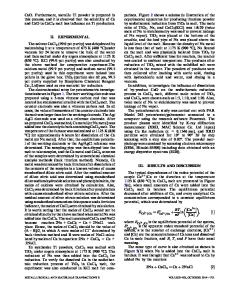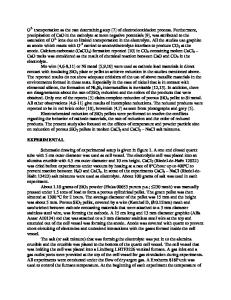Green Production of Carbon Nanomaterials in Molten Salts and Applications
This book focuses on the possible interactions that might occur between carbon materials and molten salts, and discusses the mechanisms involved in detail, highlighting possible future developments in the field. Carbon materials can be exposed to molten s
- PDF / 9,166,193 Bytes
- 171 Pages / 453.544 x 683.151 pts Page_size
- 102 Downloads / 372 Views
Green Production of Carbon Nanomaterials in Molten Salts and Applications
Green Production of Carbon Nanomaterials in Molten Salts and Applications
Ali Reza Kamali
Green Production of Carbon Nanomaterials in Molten Salts and Applications
123
Ali Reza Kamali Energy and Environmental Materials Research Centre (E2MC), School of Metallurgy Northeastern University Shenyang, Liaoning, China
ISBN 978-981-15-2372-4 ISBN 978-981-15-2373-1 https://doi.org/10.1007/978-981-15-2373-1
(eBook)
© Springer Nature Singapore Pte Ltd. 2020 This work is subject to copyright. All rights are reserved by the Publisher, whether the whole or part of the material is concerned, specifically the rights of translation, reprinting, reuse of illustrations, recitation, broadcasting, reproduction on microfilms or in any other physical way, and transmission or information storage and retrieval, electronic adaptation, computer software, or by similar or dissimilar methodology now known or hereafter developed. The use of general descriptive names, registered names, trademarks, service marks, etc. in this publication does not imply, even in the absence of a specific statement, that such names are exempt from the relevant protective laws and regulations and therefore free for general use. The publisher, the authors and the editors are safe to assume that the advice and information in this book are believed to be true and accurate at the date of publication. Neither the publisher nor the authors or the editors give a warranty, expressed or implied, with respect to the material contained herein or for any errors or omissions that may have been made. The publisher remains neutral with regard to jurisdictional claims in published maps and institutional affiliations. This Springer imprint is published by the registered company Springer Nature Singapore Pte Ltd. The registered company address is: 152 Beach Road, #21-01/04 Gateway East, Singapore 189721, Singapore
Preface
The discovery of carbon black in the early twentieth-century was followed by the discovery of nanodiamonds in 1963, fullerenes in 1985, carbon nanotubes in 1991 and graphene in 2004, introducing the main members of the so-called nanostructured carbon family. This family represents the first and most commercially successful examples of nanomaterials with a current worldwide market of several billions of dollars per year, which is continuously expanding due to their unique combination of properties including tunable electronic, thermal and surface characteristics as well as biocompatibility, chemical inertness in various corrosive media, and impressive mechanical properties. Consequently, carbon nanostructures have the capability of being used in endless applications across multiple market sectors including renewable energy, environmental protection and structural/functional composites. Carbon nanostructures are currently produced in commercial scales with techniques such as vacuum arc process, chemical vapor deposition, laser ablation and detonation, and a large number of books and book
Data Loading...











